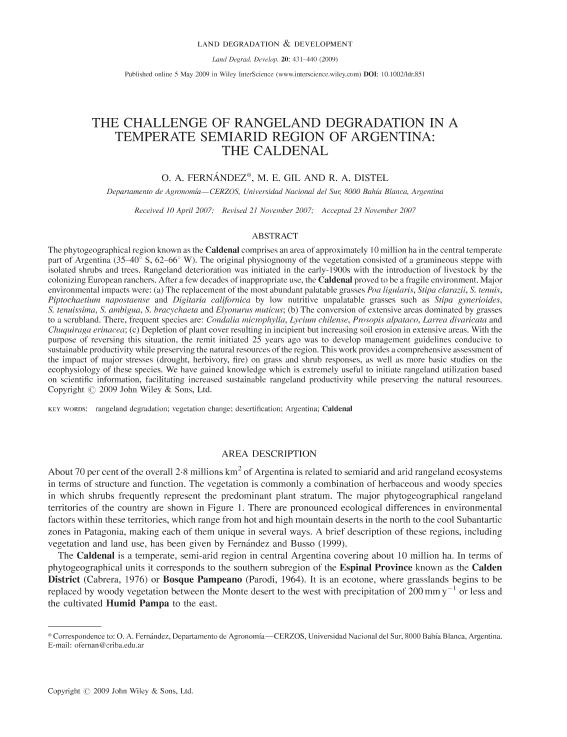Mostrar el registro sencillo del ítem
dc.contributor.author
Fernandez, Osvaldo Alberto

dc.contributor.author
Gil, María Elena

dc.contributor.author
Distel, Roberto Alejandro

dc.date.available
2017-10-19T15:58:12Z
dc.date.issued
2009-05
dc.identifier.citation
Fernandez, Osvaldo Alberto; Gil, María Elena; Distel, Roberto Alejandro; The challenge of rangeland degradation in a temperate semiarid region of Argentina: the Caldenal; Wiley; Land Degradation & Development; 20; 4; 5-2009; 431-440
dc.identifier.issn
1085-3278
dc.identifier.uri
http://hdl.handle.net/11336/26815
dc.description.abstract
The phytogeographical region known as the Caldenal comprises an area of approximately 10 million ha in the central temperate part of Argentina (35–40° S, 62–66° W). The original physiognomy of the vegetation consisted of a gramineous steppe with isolated shrubs and trees. Rangeland deterioration was initiated in the early-1900s with the introduction of livestock by the colonizing European ranchers. After a few decades of inappropriate use, the Caldenal proved to be a fragile environment. Major environmental impacts were: (a) The replacement of the most abundant palatable grasses Poa ligularis, Stipa clarazii, S. tenuis, Piptochaetium napostaense and Digitaria californica by low nutritive unpalatable grasses such as Stipa gynerioides, S. tenuissima, S. ambigua, S. bracychaeta and Elyonurus muticus; (b) The conversion of extensive areas dominated by grasses to a scrubland. There, frequent species are: Condalia microphylla, Lycium chilense, Prosopis alpataco, Larrea divaricata and Chuquiraga erinacea; (c) Depletion of plant cover resulting in incipient but increasing soil erosion in extensive areas. With the purpose of reversing this situation, the remit initiated 25 years ago was to develop management guidelines conducive to sustainable productivity while preserving the natural resources of the region. This work provides a comprehensive assessment of the impact of major stresses (drought, herbivory, fire) on grass and shrub responses, as well as more basic studies on the ecophysiology of these species. We have gained knowledge which is extremely useful to initiate rangeland utilization based on scientific information, facilitating increased sustainable rangeland productivity while preserving the natural resources.
dc.format
application/pdf
dc.language.iso
eng
dc.publisher
Wiley

dc.rights
info:eu-repo/semantics/openAccess
dc.rights.uri
https://creativecommons.org/licenses/by-nc-sa/2.5/ar/
dc.subject
Rangeland Degradation
dc.subject
Vegetation Change
dc.subject
Desertification
dc.subject
Argentina
dc.subject
Cadenal
dc.subject.classification
Oceanografía, Hidrología, Recursos Hídricos

dc.subject.classification
Ciencias de la Tierra y relacionadas con el Medio Ambiente

dc.subject.classification
CIENCIAS NATURALES Y EXACTAS

dc.title
The challenge of rangeland degradation in a temperate semiarid region of Argentina: the Caldenal
dc.type
info:eu-repo/semantics/article
dc.type
info:ar-repo/semantics/artículo
dc.type
info:eu-repo/semantics/publishedVersion
dc.date.updated
2017-10-09T15:30:56Z
dc.journal.volume
20
dc.journal.number
4
dc.journal.pagination
431-440
dc.journal.pais
Estados Unidos

dc.journal.ciudad
Hoboken
dc.description.fil
Fil: Fernandez, Osvaldo Alberto. Consejo Nacional de Investigaciones Científicas y Técnicas. Centro Científico Tecnológico Conicet - Bahía Blanca. Centro de Recursos Naturales Renovables de la Zona Semiárida. Universidad Nacional del Sur. Centro de Recursos Naturales Renovables de la Zona Semiárida; Argentina
dc.description.fil
Fil: Gil, María Elena. Universidad Nacional del Sur. Departamento de Agronomía; Argentina. Consejo Nacional de Investigaciones Científicas y Técnicas; Argentina
dc.description.fil
Fil: Distel, Roberto Alejandro. Consejo Nacional de Investigaciones Científicas y Técnicas. Centro Científico Tecnológico Conicet - Bahía Blanca. Centro de Recursos Naturales Renovables de la Zona Semiárida. Universidad Nacional del Sur. Centro de Recursos Naturales Renovables de la Zona Semiárida; Argentina
dc.journal.title
Land Degradation & Development

dc.relation.alternativeid
info:eu-repo/semantics/altIdentifier/doi/http://dx.doi.org/10.1002/ldr.851
dc.relation.alternativeid
info:eu-repo/semantics/altIdentifier/url/http://onlinelibrary.wiley.com/doi/10.1002/ldr.851/abstract
Archivos asociados
